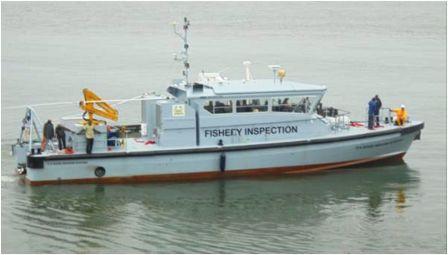A glance at Sierra Leone’s Fisheries Ministry
The fishing industry has often proved to be one of the most important areas of primary source of income in most countries. In Senegal, for instance, the fishing industry is one of the most important areas of primary sector activity. In 1994 the industry, according to an online investigation, “accounted for 8.5 percent of the GDP, employed 200,000 persons…” and that it also provided a favorable world prices and a competitive pricing as a result of the country’s 1994 currency devaluation which helped to boost the export of fish in the West African state. (Photo: John Baimba Sesay, author)
In Ghana, the sector has also been of major help in uplifting that country’s economy. In terms of employment it accounts for about 10 % of jobs in the country. The sector is primarily important to food security and job creation. What is of importance also is the fact, that most of the catch in Ghana is processed domestically, with about 60% smoked, 20% salted and the remaining 20% is said to be sold in its fresh state. (http://www.imcsnet.org/imcs/docs/ghana_fishery_profile).
In Sierra Leone, the sector has also been of great relevance in terms of contributing to the country’s Gross Domestic Product (which is about 10%) and also in addressing the problems of employment. The sector in Sierra Leone is reportedly providing employment for an estimated 100,000 persons directly and for about 500,000 persons indirectly, which is representing about 10% of the country’s population. In coastal areas, about 25% of the male population of working age is reported to be involved in part-time or full time fishing. Fishing activities in Sierra Leone is divided into two major markets-industrial fishing and artisanal fishing.
Despite these positive trends in the countries referred to above, there are also problems facing the industry. In Ghana, for instance, the artisanal fishery is reported to be lacking the infrastructure, “…available to the semi-industrial and industrial fleets…” Sierra Leone is no exception to this. There is the problem of illegal fishing in Sierra Leone – the use of destructive fishing gears and practices (such as inshore shrimp trawling, beach seines and drift nets with small mesh sizes) are damaging sensitive nursery grounds and capturing juvenile species. Also a majority of the fish caught by industrial vessels is transshipped at sea for export, with no local value added or export benefits, because there is insufficient infrastructure, nor EU-certified quality control, among other challenges.
But, governments, both past and present in Sierra Leone have fought hard in finding ways and means of addressing these and many other problems, all in an effort to increase on the sector’s contribution to the country’s GDP. There has been some level of commitment and dedication on the side of the current Minister of Fisheries and Marine Resources, Dr Soccoh Kabia and team of hardworking Ministry officials. Having some family ties in the south-Moyamba and being of the strategic areas for fishing activities, Dr Kabia, it should be noted, is fully aware of the potential of the sector to a nation’s development, little wonder, his robust actions in the ministry, coupled with the support he is getting from ministry staff. He is a Consultant Physician and Nephrologist and politician that cuts across in terms of job performance-health, social welfare and now Fisheries. He has done a lot. He brought a lot of reforms in the health sector, improved the social welfare sector of the country and is making inroads in the fisheries sector.
He has been going to different places, talking to, and with, community people, especially those in coastal areas, on the potential contribution of the fisheries sector to the country’s economy and on the need to minimize illegal fishing. This problem alone is accounting for over 30 million US dollars loss annually to our economy as a country. Some few weeks ago, ministry officials, including the Minister himself were in Sulima in the Sorogbema Chiefdom, Pujehun District and Bonthe Town. Places visited also include Shenge and Konakreedee. This was part of the Minister’s visit to outstations and fishing communities under his purview. In one of these gatherings with fishing communities, Dr. Kabia highlighted the risk the country’s fish industry is faced with due to widespread illegal fishing practices, as well as other challenges such as weak Control and Surveillance system.
We have also seen more development trends in the fisheries sector today. There has been a commitment on the part of the NEPAD to assist the Fisheries and Marine Resources Ministry develop the country’s fisheries industry in a number of areas, including Trade, Quality Control, Governance, Aquaculture, Monitoring, Control and Surveillance. Also within the ministry, we are now witnessing the implementation of the West Africa Regional Fisheries Program, a project that is aimed at strengthening the country’s capacity to manage its fisheries well.
This project is funded by the International Development Association (IDA) and Global Environmental Facility (GEF) of the World Bank, and has three interrelated components namely; (A) Good governance and sustainable management of the fisheries; (B) Reduction of Illegal Fishing and (C) ensuring an Increase Local Value Addition to fish products. The project seeks a 50% reduction of fishing vessels that are observed fishing within the 6-mile Inshore Exclusion Zone by the end of the project life cycle. It will support the strengthening of the Monitoring, Control and Surveillance of the West African Sub region to reduce illegal, unregulated and unreported (IUU) fishing and ensure that industrial fishing operations are carried out within the provisions of the laws of Sierra Leone.
The project seeks a 10 % increase in the value of exports from the coastal demersal fisheries and from the shrimp fisheries. It seeks an improved governance indicator, which entails the legal establishment of four Territorial Use Rights Fisheries (TURFs) in targeted coastal fishing communities by the end of the project; also, it seeks and increased local value added indicator-a 10 % increase in the value/volume of exports from the coastal demersal fisheries and from the shrimp fisheries.
The cumulative outcomes of the development objective of the West Africa Regional Fisheries Programme over 10 years (i.e. this first phase of 5 years and an indicated second phase of another 5 years if phase 1 meets targets set) will be: the initial recovery of the resource base of at least 7 overexploited fisheries in West Africa; at least a 25% increase in annual net economic benefits to Sierra Leone from the fisheries targeted by the project; and an increase in the average household wealth status of fishing households in targeted communities (including comparisons to non-targeted community households).
We have also seen in recent times, the fining of industrial vessels by the Ministry of Fisheries to the tune of thousands of dollars for violating the country fisheries laws. These fines, when paid, go directly into the Consolidated Revenue Fund for government’s use. This is how relevant the Ministry of Fisheries and Marine Resources has been to the country’s development agenda. And if we fully utilise the potential in this sector, by minimising the level of illegal fishing, then we are sure of gaining more from the sector.
Stay with Sierra Express Media, for your trusted place in news!
© 2011, https:. All rights reserved.






